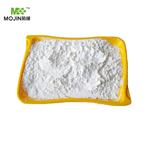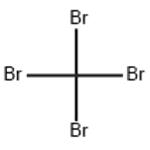- Carbon tetrabromide
-

- $0.00 / 1kg
-
2025-04-23
- CAS:558-13-4
- Min. Order: 1kg
- Purity: 99%
- Supply Ability: 100 mt
- Carbon tetrabromide
-

- $0.00 / 25KG
-
2025-03-21
- CAS:558-13-4
- Min. Order: 1KG
- Purity: 99%
- Supply Ability: 50000KG/month
- Carbon tetrabromide
-

- $50.00 / 1KG
-
2023-12-23
- CAS:558-13-4
- Min. Order: 1KG
- Purity: 99%
- Supply Ability: g-kg-tons, free sample is available
|
| | Carbon tetrabromide Basic information |
| | Carbon tetrabromide Chemical Properties |
| Melting point | 88-90 °C(lit.) | | Boiling point | 190 °C(lit.) | | density | 3,42 g/cm3 | | vapor pressure | 40 mm Hg ( 96 °C) | | refractive index | 1.5942 | | Fp | 190°C | | storage temp. | Store below +30°C. | | solubility | soluble in Chloroform | | form | Crystalline Solid | | color | White to off-white | | Water Solubility | insoluble | | BRN | 1732799 | | Dielectric constant | 7(22.0℃) | | Exposure limits | ACGIH: TWA 0.1 ppm; STEL 0.3 ppm
NIOSH: TWA 0.1 ppm(1.4 mg/m3); STEL 0.3 ppm(4 mg/m3) | | CAS DataBase Reference | 558-13-4(CAS DataBase Reference) | | NIST Chemistry Reference | Carbon tetrabromide(558-13-4) | | EPA Substance Registry System | Carbon tetrabromide (558-13-4) |
| | Carbon tetrabromide Usage And Synthesis |
| Description | Carbon tetrabromide is considered a highly toxic chemical,
may be fatal if inhaled, swallowed, or absorbed through skin.
It is metabolized in vitro to produce carbon monoxide but
the in vivo significance has not been established. Under
anaerobic reducing conditions it forms complexes with
ferrous cytochrome P450. Carbon monoxide is detected as
a metabolic product of the interaction. Carbon tetrabromide’s
production and use in organic syntheses may
result in its release to the environment through various waste
streams. Carbon tetrabromide has been isolated from red
algae, Asparagopsis toxiformis, found in the ocean near Hawaii.
It was detected in water from treated chlorinated seawater
used for drinking at oil platforms. Occupational exposure to
carbon tetrabromide may occur through inhalation and
dermal contact with this compound at workplaces where it is
produced or used. The general population may be exposed to
carbon tetrabromide via ingestion of drinking water. Acute
exposures to high concentrations may cause upper respiratory
tract irritation and injury to lungs, liver (hepatotoxicity)
and kidneys (nephrotoxicity). Chronic exposure effects at
very low levels will be almost entirely limited to liver injury.
It is a potent lachrymator even at low exposure concentrations.
Although carbon tetrabromide may release bromine
ions during metabolism, clinical bromism is not expected to
occur. | | Chemical Properties | Carbon tetrabromide, is a colorless powder,
white crystalline solid, or yellow-brown crystals. Slight
odor | | Uses | Carbon tetrabromide is used to a limited extent as a chemical
intermediate. It has been isolated from red algae, Asparagopsis
toxiformis, found in the ocean near Hawaii. | | Definition | ChEBI: A one-carbon compound substituted by 4 bromo groups. | | Application | Carbon tetrabromide (CBr4) is a multifunctional chemical reagent widely used in chemical and pharmaceutical industries. It mainly includes:
(1) As a thiophilic reagent, it promotes the one-pot oxidative condensation of amines with N,N'-disubstituted thioureas to give a variety of guanidine derivatives[1].
(2) As a bromine radical precursor, used in the electrochemical radical bromination and cyclisation sequence of enoic acid to prepare bromomethylated γ-lactone derivatives[2].
(3) As a precursor of hydrogen atom transfer reagent, used to generate aromatic carbonyl compounds[3].
(4) As raw materials or intermediates for organic synthesis. Synthesis of N-sulfonylformamidine from CBr4 and formamide under UVA irradiation. Activated imine intermediates (Vilsmeier-Haack reagent derivatives) were obtained via a photoinduced reaction between CBr4 and formamide[4]. | | General Description | A colorless crystalline solid. Much more dense than water and insoluble in water. Toxic by ingestion. Vapors are narcotic in high concentration. Used to make other chemicals. | | Air & Water Reactions | Insoluble in water. | | Reactivity Profile | Carbon tetrabromide is incompatible with the following: Strong oxidizers, hexacyclohexyldilead, lithium . | | Hazard | A poison; narcotic in high concentration.
Liver damage, eye, skin, and upper respiratory tract
irritant. | | Health Hazard | Highly toxic, may be fatal if inhaled, swallowed or absorbed through skin. Avoid any skin contact. Effects of contact or inhalation may be delayed. Fire may produce irritating, corrosive and/or toxic gases. Runoff from fire control or dilution water may be corrosive and/or toxic and cause pollution. | | Fire Hazard | Non-combustible, substance itself does not burn but may decompose upon heating to produce corrosive and/or toxic fumes. Containers may explode when heated. Runoff may pollute waterways. | | Safety Profile | Poison by
subcutaneous and intravenous routes.
Narcotic in high concentration. Mixture
with Li particles is an impact-sensitive
explosive. Explodes on contact with
hexacyclohexylddead. When heated to
decomposition it emits toxic fumes of Br-.
See also CHLORINATED
HYDROCARBONS, ALIPHATIC. | | First aid | If this chemical gets into the eyes, remove anycontact lenses at once and irrigate immediately for at least15 min, occasionally lifting upper and lower lids. Seek medical attention immediately. If this chemical contacts theskin, remove contaminated clothing and wash immediatelywith soap and water. Seek medical attention immediately. Ifthis chemical has been inhaled, remove from exposure,begin rescue breathing (using universal precautions, including resuscitation mask) if breathing has stopped and CPR ifheart action has stopped. Transfer promptly to a medicalfacility. When this chemical has been swallowed, get medical attention. Give large quantities of water and inducevomiting. Do not make an unconscious person vomit.Medical observation is recommended for 24-48 h afterbreathing overexposure, as pulmonary edema may bedelayed. As first aid for pulmonary edema, a doctor orauthorized paramedic may consider administering a corticosteroid spray. | | Environmental Fate | Carbon tetrabromide inhibits protein synthesis and causes
lipid peroxidation, both of which may be involved in cell injury
or death mediated by free radicals. | | storage | Color Code—Green: General storage may be used.Prior to working with carbon tetrabromide you should betrained on its proper handling and storage. Store in tightlyclosed containers in a cool, well-ventilated area away fromoxidizers and other incompatible materials listed above. | | Shipping | UN2516 Carbon tetrabromide, Hazard Class:
6.1; Labels: 6.1-Poisonous materials. | | Purification Methods | Reactive bromide is removed from CBr4 by refluxing with dilute aqueous Na2CO3, then steam distilling, crystallising from EtOH, and drying in the dark under vacuum. [Sharpe & Walker J Chem Soc 157 1962.] It can be sublimed at 70o and low pressure. [Beilstein 1 IV 85.] | | Toxicity evaluation | Carbon tetrabromide is a colorless nonflammable solid at
room temperature. It is insoluble in water, but soluble in several organic solvents such as alcohol, ether, and chloroform.
Its specific gravity is 3.42, melting point is 90°C, boiling point
is 189°C, and vapor pressure is 0.72 torr at 25°C. Production
and use of carbon tetrabromide may result in its release in the
environment through various hazardous waste streams.
Carbon tetrabromide is expected to have very high mobility in
soil and volatilizes slowly from dry soil surface. Its biodegradation
is expected to be slow and to exist solely as a vapor in
the ambient atmosphere. It is not expected to adsorb to suspended
solids and sediment in the water column. Its potential
for bioconcentration in aquatic organisms is moderate. | | Incompatibilities | Incompatible with oxidizers (chlorates,
nitrates, peroxides, permanganates, perchlorates, chlorine,
bromine, fluorine, etc.); contact may cause fires or explosions. Keep away from alkaline materials, strong bases,
strong acids, oxoacids, epoxides, lithium and hexacyclohexyldiilead, since violent reactions may occur. | | Waste Disposal | Purify by distillation and
return to suppliers. | | References | [1] B. YADAV; S. K S; N Srivastava. Carbon Tetrabromide-Mediated Guanylation of Amines with N,N′-Disubstituted Thioureas: An Easy Access to Guanidines[J]. Russian Journal of Organic Chemistry, 2024. DOI:10.1134/S1070428023100093.
[2] KYEONG SEOP KIM;Dae Y K. Electrochemical bromolactonization of alkenoic acids with carbon tetrabromide: Synthesis of bromomethylated γ-lactones[J]. Accounts of Chemical Research, 2022. DOI:10.1080/00397911.2022.2028843.
[3] CHUNBO BO. Visible-Light-Initiated Air-Oxygenation of Alkylarenes to Carbonyls Mediated by Carbon Tetrabromide in Water[J]. ACS Applied Polymer Materials, 2023. DOI:10.1002/cssc.202301015.
[4] QUENTIN CHEVRIER, LéO BETTONI*; Synthesis of N-Sulfonyl Formamidines by Direct Condensation between Sulfonamide and Formamide Enabled by a Photogenerated Vilsmeier-Type Reagent[J]. ACS Applied Electronic Materials, 2024. DOI:10.1021/acs.joc.4c0216010.1021/acs.joc.4c02160.
|
| | Carbon tetrabromide Preparation Products And Raw materials |
|